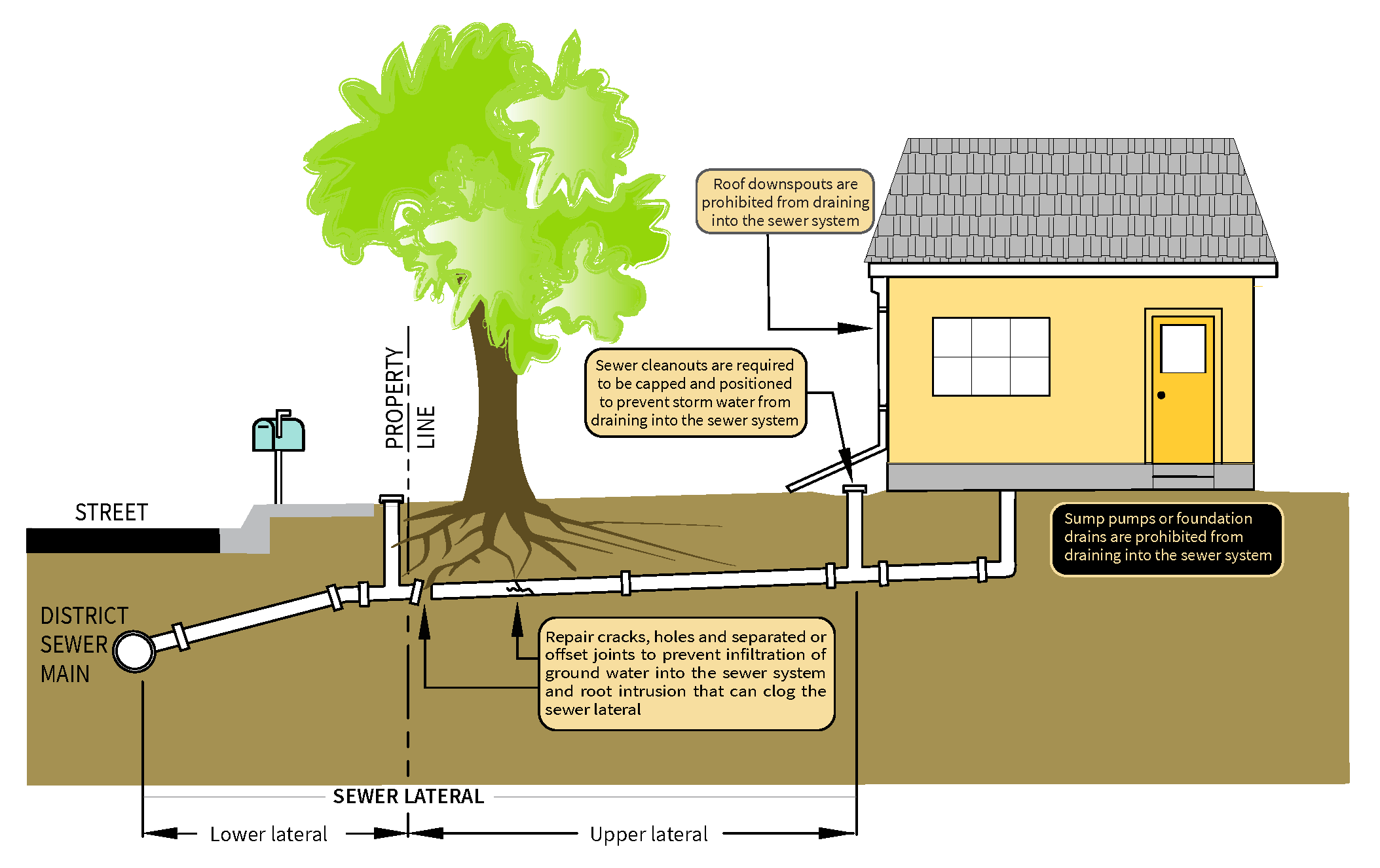Private sewer laterals are the pipes that lead from homes or businesses to the sewer main. Normally, the costs of replacing or repairing private sewer laterals are the responsibility of the property owner.
Leaking private sewer laterals are often one of the main sources of inflow and infiltration, commonly referred to as I&I, that increases the amount of wastewater that must treated by the District at its treatment facility. I&I is usually a result of leaky or deteriorating laterals and sewer main lines, which allow groundwater and stormwater to seep into pipes, increasing the amount of water flowing to the Wastewater Treatment Plant for treatment. Additional water from I&I increases the pumping and sewage treatment cost for the Wastewater Treatment Plant.
It is the responsibility of the property owner to clean, maintain and replace their private sewer lateral. Many of the sewer lateral pipes are old, and are at risk for leaking raw sewage into the ground, causing plumbing problems in your home or business and contributing stormwater inflow to the sewer system during wet weather. Private building laterals can be compromised by tree root intrusions, grease buildup, pipe cracks, and pipe sags.
Sonoma Valley County Sanitation District Private Sewer Lateral Ordinance:
In response to the aging infrastructure, The Private Sewer Lateral Ordinance requires owners of property that are 30 years or older to have their sewer laterals inspected and repaired, if necessary, in order to prevent sewer overflows that contribute to pollution and result in costly fines to the District. An estimated two-thirds of the sewer laterals in Sonoma Valley are at least 30 years old and likely in need of repair.
In response to this issue, the District will be conducting video inspections and smoke testing of sewer laterals to property owners.
If you choose to decline this free inspection, you must notify the District by mail or by email at LateralRepair@scwa.ca.gov. If the District does not receive notice of declining the inspection, the District will proceed with the free inspection. Property owners who decline this free inspection may be required to hire a qualified company that can produce a video/report in accordance with the National Association of Sewer Service Companies (NASSCO) Lateral Assessment and Certification Program (LACP), at the property owner’s expense.
Property owners will be notified only if their laterals require repair/replacement following completion of the inspections. Where significant defects are identified, property owners will have one year from the report date to complete any necessary repairs identified in the report.
Learn more about Sonoma Valley County Sanitation District
FAQ: What You Need To Know About Your Private Sewer Lateral
Q: What is a private building lateral?
A: A private sewer lateral is an underground pipe that conveys wastewater from your building to the sanitary sewer system. Typically the private sewer lateral goes from your building to the sewer main in the street.
Q: Who is responsible for the maintenance of a private sewer lateral?
A: The property owner is responsible for all maintenance, operation, cleaning, repair and reconstruction of the private sewer lateral from the building to the point of connection with the sewer main.
Q: What are some potential points of failure for a private sewer lateral?
A: Over time, private sewer laterals can crack, become disjointed or displaced, and allow tree roots or debris to build up. These defects cause blockages and building backups, overflows into the environment, and rain water infiltration into the sewer system.
Q: How do I know if there is something wrong with my private sewer lateral?
A: Private sewer laterals are underground so most people won’t see a problem at the ground surface. Older private sewer laterals and laterals in the vicinity of trees or large bushes are more likely to have problems. A local plumber can inspect private sewer laterals by using a video camera to look for cracks, joint separation, root intrusion, blockages and pipe sags.
Q: How often should I perform maintenance on my private sewer lateral?
A: Private building lateral maintenance depends on several factors including age of pipe, pipe material, and site. It is generally recommended to have older private sewer laterals inspected and cleaned every couple years. Most plumbers can inspect and clean a private sewer lateral.
Q: What are the consequences of not maintaining my private sewer lateral?
A: Private sewer laterals develop defects over time and contribute to sewer backups into the building, environmental pollution, more expensive private sewer lateral repairs, and more expensive costs for the local treatment plant. In some circumstances, the property owner can be liable for any environmental damage and the governing regulatory agency could be forced to terminate sewer service until the private sewer lateral is repaired.

